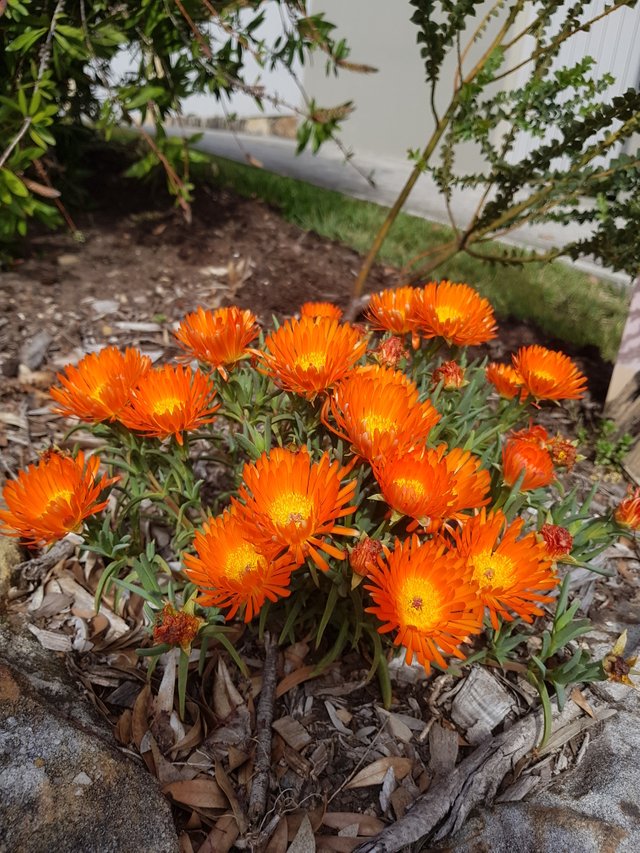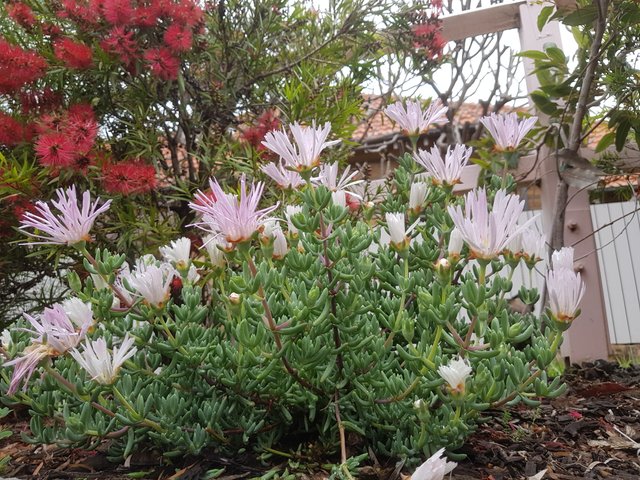Pigface - beautiful plant, unfortunate name.
Pigface is the Common name for a group of succulent plants, the Mesembryanthemum and Lampranthus which are both native to Africa, and the Australian Native Pigface, Carpobrotus. All of these species of Pigface share similar characteristics... they are low-growing groundcover plants with green to grey succulent leaves. The leaves are fleshy and full of water, which means the plant will tolerate ( and prefers ) a well, drained soil and dry, hot conditions where it puts on a fabulous display of flowers in Spring and Summer. Pigface flowers come in almost any colour, and are similar to daisy flowers, although they only open up fully on days where they get full sun, not on cloudy or overcast days.
Pigface are a great plant for rockeries, and garden borders where they are planted in front of taller growing shrubs, or they are also good for pots. The trailing growth habit means they spill over rock walls, and this makes them ideal for hanging baskets too. You will find them very easy to grow, and will cover an area quite quickly. Sandy, well drained soil is preferable, as the plants don't like to have wet roots. I took these photos in local Sydney gardens.

This ground-hugging plant with its fleshy, drought-resistant leaves is at its most spectacular when it opens its bright pink flowers. Flowering happens at any time of year, depending on location. An introduced pigface species, Carpobrotus edulis, has yellow flowers.
Pigface is a valuable food plant. Its scientific name is derived from Greek words meaning ‘edible fruit’ – a fact well-known by Tasmanian Aborigines. For a guaranteed food source in dry, lean times they would camp close to the plant they knew as wend-dar.
Most valued was the sweet red tasty fruit, with a flavour compared to strawberries, figs, kiwi fruit and raspberries. The fleshy leaves were also eaten cooked, and the juice from the leaves was used to soothe blisters, burns and pain from insect bites.
source
Fav. comment Award ! Great comment with nice Pics and information.
@ctrl-alt-nwo,
Wow it's beautiful! I see different colors of this flower in my country also! You could made a stunning photography of these flowers and personally I like that photography #1!
Cheers~
Wow look on this wonderful color that make it look such a live
Carpobrotus is a water-retaining plant, widespread in coastal areas of Southern Australia and in many parts of the world. Well exposed to coastal locations, this plant is a genus of about 25 species. Its beautiful daisy-like purple flowers are common to sand-dunes and are winter to spring flowering. Some of the species have some peculiar names; you might need a vivid imagination in order to see a connection between the plant’s flower and its common name.
Carpobrotus rossii is a prostrate plant, which has a beautiful purple colored flower with a white center. Amazingly they are known as the Pig Face plant, though you may not find any resemblance between the flower and a pig’s face. It is a salt-resistance plant and can be found year round in coastal areas. In Australia, people used to eat its fruit. Juice from its leaves was used to relieve burns and pains.
This plant is known as the Hottentot Fig, Highway Ice-plant, Sour fig or sometimes the Ice-Plant. It is a beautiful plant native to South Africa, which has yellow, pink or orange flowers and fleshy fig like fruit. Carpobrotus edulis, is a fast-spreading plant with bright flowers. Not only its fruits are edible, but the leaves too, which taste like a pickled cucumber. It flowers from June to August, and is able to inhabit rocky places.
Source: http://scribol.com/environment/plants/the-bizarrely-named-pigface-flower/
Carpobrotus, commonly known as Pigface, Ice Plant, and Hottentot Plant, is a genus of ground-creeping plants with succulent leaves and large daisy-like flowers. The name refers to the edible fruits. It comes from the Ancient Greek karpos (“fruit”) and brota (“edible”).
The genus includes about 20 accepted species. Most are South African, endemics, but there are at least four Australian species and one South American.
Various Carpobrotus species are invasive introduced species in suitable climates throughout the world. The harm they do is variable, and sometimes hotly debated, when balanced against their value as firebreaks and as food for wildlife.
https://worldofsucculents.com/how-to-grow-and-care-for-carpobrotus/
Thanks again for sharing some great photos.
It's always a pleasure to share your Blog on twitter for my followers to see and promoting #Steemit at the same time.
Have a great weekend.
Stephen
#Promo-Steem #steemtalent #JoinSteemit #Steemit
Pigface - beautiful plant, unfortunate name. #STEEM #steemtalent #JoinSteemit #Steemit
#garden #gardening #gardensworld #plant #life #blog #blogger #australia #photography #photographer
https://twitter.com/StephenPKendal/status/1058690891609767938
Carpobrotus edulis is an easy to grow, water wise succulent with large 3-angled leaves and edible fruits. It forms dense mats and is frequently used for stabilizing sandy areas, dunes and embankments. It is fire-resistant and can be planted around a property in fire-prone areas. Once established, this plant is truly water wise and requires little attention. Because this plant is often undisturbed for long periods of time, it creates a sanctuary for a variety of small creatures including reptiles, rodents and a range of bugs and beetles.
Carpobrotus edulis thrives on neglect. It needs well-drained soil, a sunny position and room to spread. It is an excellent evergreen drought and wind resistant groundcover that thrives happily on flat, sandy ground and loose sand dunes, in stony soil and lime-rich or brackish soils. When planted as a groundcover around the house, this juicy vygie creates a fire-resistant barrier. Avoid use of fetilisers and compost.
http://pza.sanbi.org/carpobrotus-edulis
Beautiful plant, my friend and Carpobrotus glaucescens is a prostrate, creeping succulent that has long trailing stems to 2 m long, which root at nodes along the stems. From these nodes the plant produces upright leafy branches. It has thick, fleshy, smooth leaves 3.5-10 cm x 1-1.5 cm, which are triangular in cross section. The plant grows to form a groundcover that can cover a large area.
The plant produces large, striking, deep pink-purple daisy-like flowers from October to January, but also can flower sporadically throughout the year. The plant produces a red-purple berry fruit, which was used by the native aborigines as a food source. The flesh of the fruit is said to have a taste similar to salty apples. The roasted leaves have been used as a salt substitute. Early European explorers used the plant as an anti-scurvy treatment. The juice of the leaves can also be used to relieve pain from insect bites.
Carpobrotus glaucescens is found growing naturally in coastal areas on sand dunes along the NSW and Queensland coast, north to Rockhampton. It also grows down into the east coast areas of Victoria. Pigface grows on the front of sand dunes and acts as a stabilizer where it helps to bind the sand, this allows more effective sand stabilizers such as spinifex grass to take a hold. Being a pioneer species it is important in paving the way for more complex communities.
As would be expected C. glaucescens is very salt tolerant and is able to withstand salt spray, strong winds and sand blast. If covered with sand the plant can survive, grow upwards and produce a new plant mat over the old one.
Pigface is generally a summer-spring growing plant. It can be grown either from seed or cuttings. Propagation is easiest by layering (rooting horizontal stem cuttings), as this is how the plant grows naturally. These layers should be around 30 cm in length and planted leaving at least 5 cm of the plant above the sand or soil. The plant can also be grown from cut pieces or division of large plants.
C. glaucescens will grow in most relatively well-drained positions in either full sun or partial shade; though an open sunny position is best. Pigface can also tolerate extended dry periods. Pigface is relatively pest free but may be attacked by scale insects in summer.
Carpobrotus glaucescens makes a colourful hardy and attractive groundcover suitable for the garden and is very useful for wind erosion control and for binding loose sandy soils. Over very large areas of sand dunes it is best planted in combination with Spinifex (Spinifex sericeus ) and Goats-foot (Ipomoea pes-caprae) as it seldom provides complete cover. Pigrace is definitely an attractive plant suitable for rockeries, low maintenance gardens or gardens with a sea side frontage.
Thank you @ctrl-alt-nwo
A source of information: https://www.anbg.gov.au/gnp/interns-2005/carpobrotus-glaucescens.html